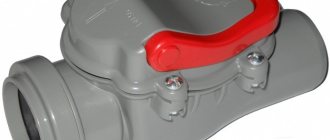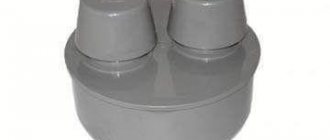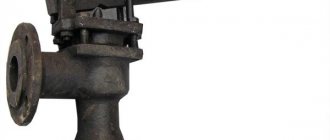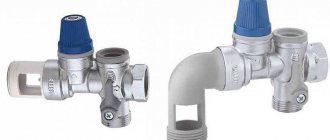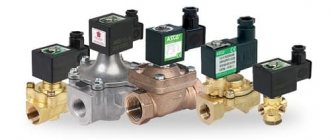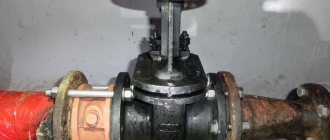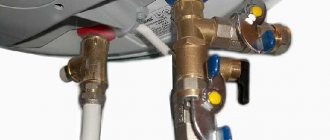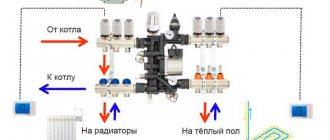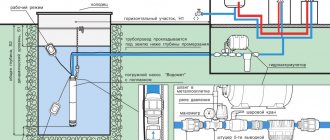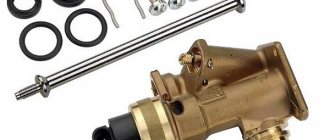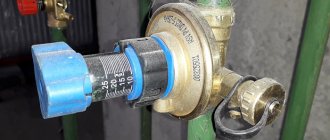The opportunity to enjoy all the benefits of civilization would be incomplete without a modern drainage system. The first sewer networks rid city streets of sewage and unpleasant odors accompanying human waste. But there is no limit to perfection.
Sanitary technology keeps up with the times, new technologies and equipment make our lives easier and more comfortable. These new products also include a vacuum valve, which makes it possible to make intra-house sewage simpler and more perfect.
Why is a vacuum valve needed in a sewer system?
The vacuum valve is a special automatic device designed to ensure normal hydraulic conditions and tightness of the building's sewage system.
All plumbing fixtures are equipped with special water seals in the form of a V-shaped siphon. Thanks to them, the device always has a certain amount of liquid left, which does not allow gases and unpleasant odors formed in the sewer to enter the premises.
However, during the “drain-flush” process, the waste liquid, having filled the entire cross-section of the pipeline, creates a kind of “piston” in it. As it moves through the pipe, a vacuum zone forms behind it, literally sucking water out of the siphon.
It is to compensate for these pressure fluctuations that the vacuum valve serves.
Being installed on such a sewage system, it will automatically open when the pressure in the pipeline decreases and equalize it with atmospheric pressure. Now, even with the simultaneous operation of several plumbing fixtures, discharge and “breakdown of the siphon” are practically impossible.
Vacuum valves are recommended for use in the following cases:
- If it is impossible to install a ventilated sewage system in a building due to its design or other features.
- When connecting several devices at once to a long horizontal section and if it is possible for them to operate simultaneously.
- If the installed plumbing equipment is located at a significant distance from the ventilated riser.
- For installation of local sewage systems for low-rise buildings.
- In order to save materials.
Note! Hermetic shut-off of the valve, especially in the event of excess pressure in the pipeline (in case of blockage), makes installation possible at any, even the lowest point of the network.
Vacuum valve device for sewerage
The sewer system cannot function properly without ventilation.
If the latter is not arranged correctly, problems arise. An unpleasant odor appears in the premises. Installing a 50 mm air check valve for sewerage helps to cope with this. Regardless of the housing design, the general principle of operation of the vacuum valve is similar for all products.
The principle of operation of ventilation in the sewer system
Drain outlets of plumbing fixtures are connected to the general sewer system. Wastewater is discharged spontaneously into a riser, which is a vertically located pipe, the diameter of which is most often 110 mm. It passes through several apartments, at the bottom it opens into a collector. From the reservoir, wastewater enters a centralized system.
The top hole is located above the roof level. The plug is not installed here. The ventilation hole allows air to pass through, which is needed to maintain the required pressure in the public sewer system.
This system is called a fan pipe. It is installed in all multi-storey buildings. Sometimes it is impossible to arrange such a structure. If the vent is located a short distance from the windows, the apartments will smell like sewage.
Why do you need a valve for a sewer riser?
The vacuum sewer valve is mounted at the top of the riser and near plumbing fixtures.
The sewer system may not function properly for the following reasons:
- Failure to comply with rules and regulations. If the installation of the fan structure is carried out incorrectly, an unpleasant odor penetrates into the premises.
- Violation of the integrity of the riser.
- Clogged top of pipe. Leaves, particles of building materials, birds and animals can get into the hole.
- Freezing of the outlet of the fan structure. In this case, the air flows in insufficient quantities.
- Lack of ventilation structure.
When water is drained, a vacuum occurs in the collector. If the pressure drops, the siphon seals disappear. As a result, an unpleasant odor and noise appear in the room. Sewage gases pose a danger to humans.
If the problem is not eliminated, fungus begins to spread in the bathroom and toilet rooms. Installing an aeration valve on the drain pipe helps to avoid this. The part promotes the regular flow of air, equalizing the pressure.
It can be used in combination with a fan system.
Design and principle of operation of the fan valve
The ventilation valve consists of the following components.
- Frame. There is a channel in the side through which air flows penetrate. The body is made of polypropylene or polyvinyl chloride.
- Lid. The removable element allows the valve to be cleaned.
- Membrane. Made from rubber.
- Sealing gasket. Determines the amplitude of movement of the rod and imparts tightness to the structure.
On the left – the valve is open, on the right – the valve is closed.
The device works like this:
- When the pressure in the pipe is equal to atmospheric pressure, no air enters from outside.
- When you drain a toilet tank, bathtub, or other appliance, a vacuum occurs in the riser. The rod moves, causing air currents to flow.
- The pressure in the sewer system is equalized. The rod returns to its previous position, the air flow stops.
Pros and cons of aerators
The positive qualities of the aerator include:
- Normalization of sewerage work. Installing an auxiliary part prevents the spread of an unpleasant “aroma” that is dangerous to the human respiratory system.
- Possibility of refusing to install a drain pipe. The placement of the aerator allows you to avoid creating an exit in the roof of a private house.
- Possibility of installation in a non-ventilated riser. In this case, the valve only works effectively in a low-rise building. In multi-storey buildings, the part is used in combination with a fan structure.
The disadvantages include the possibility of the rod jamming. This is caused by membrane wear or clogging of the aerator. The second is unlikely; debris gets into the case only when the lid is opened.
Technical characteristics, diameters and manufacturers
Important technical parameters of the device are:
- Diameter. Selected according to pipe dimensions. The diameter can be 5, 7.5 or 11 cm. The first 2 types are installed on intra-apartment systems, the last - on the riser. Some valves can be placed on sewer elements of different sizes. This becomes possible thanks to the introduction of a stepped pipe. On pipes of non-standard sizes, tees with a ventilation valve are installed.
- Bandwidth. This parameter reflects the volume of air entering per second. For 1 l/s of wastewater, up to 25 l/s of gas is required. The valve capacity can reach 37 l/s.
In our country you can purchase vacuum valves manufactured by HL (Austria), McAlpine (Great Britain), Wavin (Poland), Europlast (Ukraine), Ostendorf (Germany).
How to choose the right valve?
When choosing a device, take into account the layout of the sewer riser, the pressure in the system and the dimensions of the pipe. Important parameters include the installation method, the durability of the material, the possibility of manual repair if the locking mechanism breaks down, and protection against the penetration of rats and mice.
Where and how to install the valve correctly?
The vacuum valve must be installed in a free place - this will provide access to the device for inspections.
When placing the valve, the following rules must be observed:
- If the aerator is installed in the attic, the temperature should not be allowed to drop to sub-zero levels. This may disrupt the system.
- In a shower room with a drain on the floor, the device is installed at a height of at least 35 cm from the surface.
- You must maintain access to the device. This allows inspection and repairs to be carried out. Particular attention is paid to this point in the absence of a fan structure.
- The valve is placed 30 cm above the topmost outlet. Other pipes are not placed within the specified radius.
- The distance from the siphon to the aerator should be more than 20 cm.
Possible locations for installing the device
There are 3 suitable places for installing the device:
- Riser. The aerator is located at the top of the pipe, leading into the attic or leaving it in the toilet room.
- Near the outlet of the drain hose of a plumbing fixture. The device is often installed when installing a washing machine or dishwasher.
- Long sewer elements located vertically.
Step-by-step installation instructions
If a ventilation valve is installed in a multi-story building, you need to notify the other residents. After shutting off the water supply, perform the following actions:
- Cut out a part of the pipe in place of which the device will be placed.
- The valve with a sealing gasket is inserted into the adapter. The arrow on the aerator body must correspond to the direction of water flow.
- The adapter is installed in place.
The valve can be mounted without using an adapter or elbow.
Valve device
The sewer vacuum valve is a cylindrical shut-off and control device made of plastic. Despite the importance of the functions it performs, it is a very simple product and consists of the following parts:
- Housing (has a specially shaped partition separating the receiving chamber with a side window from the working one).
- Protective cover (attached to the housing to prevent debris and foreign objects from entering the receiving chamber).
- A rod with a damper (installed above the dividing partition, serves to automatically respond to pressure differences in the network).
- Rubber gasket (mounted under the damper rod, designed for its tight seal and shock absorption).
We recommend that you read: HDPE pipe for laying cables in the ground
The valve is designed for installation in a socket connection.
When installing on plastic (PVC) pipelines, a standard seal is used; for a cast iron sewer pipe, a special adapter is required.
Products from some manufacturers are equipped with a rubber membrane instead of a plastic rod. There are two main standard sizes of valves in accordance with the connecting diameters: 50 and 110 mm.
DIY sewer check valve
In all systems where water is used, it is assumed to flow in a certain direction.
Backflow can be caused by various reasons, which we will look at later, and is considered an emergency situation.
A check valve will help prevent system failures. You can also make this mechanism with your own hands. Let's look at how to make a check valve for a pump and sewer with your own hands, where the device is used and how it works.
Operating principle of a check valve
Check valves may differ in appearance and design, but the essence of their work is the same: they easily allow water (or the flow of another substance) to pass in one direction and block its movement in the opposite direction.
It helps protect sewer and water supply equipment from damage.
Operating principle of a check valve
The valve design is:
- Two cylinders located at right angles to each other.
- There is a single cavity inside.
- One of the cylinders is threaded on both sides for installation in a pipe system.
- The other cylinder is plugged.
- In the cavity there is a simple mechanism (different, depending on the type - ball, sash, etc.), which opens in one direction.
Application area
Here are just a few examples of the use of check valves in private and municipal water supply, heating and sewerage systems:
- It happens that due to pressure surges in the water supply (including from the pump), hot water is squeezed through cold water. That is, when you open a cold water tap, hot water flows for some time. In this case, installation of a check valve on the cold supply pipe is indicated.
- The device installed before the water pump will prevent water from draining into the well, and will also protect the equipment from damage in the event of reverse spinning of the working blades.
- In front of the water meter. The water pressure and vibration that is created can harm devices and distort meter readings. Vibration does not spread after the shut-off valves.
- Double-circuit gas (solid fuel or other boilers) must also be equipped with an appropriate valve to prevent the return of already heated water.
- Solar collector. Here, circulation disturbances may be associated with a small difference in the temperature of the liquid at the inlet and outlet, or a slight difference in height (if the water heater is small). It would be a good idea to equip the solar water heater inlet pipe with anti-reverse protection.
- Drainage pumps begin their work by filling the device with water. Many owners find this procedure tedious and come up with ways to avoid it. To prevent water from pouring out of the unit, a valve is placed on the suction hose.
- Where groundwater rises strongly, it is important to install a check valve on the pipe connecting the drainage pit and the house so that when the liquid level rises, it does not flow back.
In some of the listed cases, installing a valve is desirable, while in others (such as with a boiler) it is mandatory and is specified in the accompanying documentation.
[sticky-ad id=13532]
Check valves can be divided according to materials:
- cast iron;
- brass;
- from various steels;
- plastic.
The latter are often preferred due to their low cost.
By design, there are four main types of valves:
- Ball.
- Rotary (petal or return).
- Lifting.
- Wafer.
Let's consider their features.
Ball
The spring-loaded ball is made of rubber or cast iron coated with rubber.
During normal flow movement, the ball moves backward and allows liquid to pass through; during reverse movement, it tightly blocks the outlet.
Suitable for outdoor sewerage and where good throughput is required.
It is recommended to install fittings in the heating system that create minimal resistance, since the temperature in the house directly depends on the speed of water movement.
Rotary
The petal covering the inlet is mounted on a hinge and, like a regular door, “swings open” from the movement of water.
It does not interfere with the flow because, when opened, it is placed in a plugged side branch of the valve.
The disadvantage of the design is that when the water pressure drops and the petal slams shut, a water hammer occurs.
This is not so bad if the valve diameter is not large, but in large structures the impact can damage the mechanism itself or the devices that it is designed to protect.
For valves of large diameters, a shockless butterfly valve design has been developed - with a soft stroke.
Lifting
This design has a curved fluid flow.
In the Perpendicular compartment there is a mechanism made of a spring and a spool, which, under the pressure of water, rises upward and is pressed against the plugged part of the device.
For normal operation of the reinforcement, it is important that it is placed on a horizontal section, and the plugged section is located strictly vertically.
The mechanism is sensitive to the quality of the liquid - dirty water can damage it over time.
Wafer
They, in turn, are divided into:
Disk. Its shutter is made in the form of a round plate, which in its normal position is pressed against the saddle by springs.
But the pressure created by the flow of water deflects the disk, and water flows through the pipe.
However, the turbulence created by this design makes it not suitable for all cases.
Bivalve. In the second case, the shutter consists of two halves attached to a rod in the center of the device. The flow of water folds them and passes through the pipe, with virtually no resistance.
The advantage of the miniature design is that it can be installed vertically, horizontally, and at an angle.
Both versions of wafer valves are easy to install by clamping them between flanges and bolting them together. The scheme practically does not lengthen the pipeline, and the mechanism weighs 5-8 times less than other analogues of the same diameter.
Making a check valve for water with your own hands
To work you need to prepare:
- coupling with external thread;
- female tee;
- spring (freely included in the tee);
- steel ball (slightly smaller than the internal diameter of the tee);
- threaded plug;
- FUM tape.
If there is no suitable spring, you can make it yourself.
You need a wire and a rod of the required thickness so that you can wind steel wire onto it.
A hole is made in the rod and the end of the wire is inserted into it. To make it more convenient, clamp the rod in a vice and wind the required number of turns (with pliers).
Now you can proceed to valve assembly:
- A coupling is screwed into the tee so as to block the side hole by about 2 mm (so that the ball does not jump out there in the future).
- A ball is inserted from the opposite end, then a spring.
- This end is tightly sealed with a stopper on the FUM tape.
The water flow in a homemade valve will enter from the coupling side, push the ball away, and exit from the perpendicular end of the tee.
The most important thing here is to adjust the spring correctly so that it does not deflect when the pressure subsides, but is not too tight and does not interfere with normal circulation.
It only remains to add that in stores a check valve can cost between 800 and 3000 rubles.
The decision whether to make a locking element yourself or buy one must be made based on a real assessment of your capabilities as a craftsman.
After all, the device, although simple, plays an important role in the system. Miscalculations and lack of tightness can be costly in an emergency situation.
on the topic
Check valve for sewerage: types, types, tools, installation instructions yourself
A non-return (or vent) valve will help protect against sewage breaking into an apartment on the ground floor through a toilet or sink. Let's find out how it works and how to install it yourself.
Flooding of an apartment is a very unpleasant event, fraught with unscheduled repairs. And if flooding causes sewage water to erupt from a toilet or sink, the consequences can be catastrophic.
A check valve installed on the sewer pipe will provide reliable protection against such a nuisance.
Let's find out when installing a check valve is required, how this unit works, and how to install it yourself.
Ball
Sewage flooding is especially likely in high-rise buildings, where several apartments are located on one vertical pipe.
Even one plastic bag may be enough to clog the riser, and then yes, not finding its way, will rush back, splashing out of all the drain holes.
This situation is especially likely in old houses, where the pipes are covered on the inside with thick crusts of deposits.
The risk of backflow of waste water is especially high in apartments on the ground floor. Often at night in such apartments it is necessary to plug the drains with rags, plugs and other improvised plugs.
But if valves are installed on the first floors, water can break through on the second floor.
Operating principle of the aerator
The valve actuation mechanism is simple; it can be classified as a direct-acting device, that is, the system parameters directly affect the valve stem. The working chamber of the aerator is directly connected to the pipeline, and the pressure in them is the same.
Due to the special design of the aerator valve body, the rod is located above the seat hole in the partition separating the receiving and working chambers. At the same time, it can move from the seat to the upper part of the working chamber, opening free communication between the chambers.
When the pressure in the sewer system is equal to atmospheric pressure, the valve rod is pressed by its own weight to the seat hole and closes it. The chambers are isolated from each other, the escape of gases and the spread of accompanying unpleasant odors is impossible.
When a vacuum occurs in the sewer pipeline (due to flushing the toilet or emptying the bathtub), the rod, under the influence of higher atmospheric pressure, moves upward to a lower zone.
In this way, the chambers are combined into one whole, the pressure in them and, accordingly, in the pipeline, is compared to normal. Breaking the siphon becomes impossible.
Note! The valve has high sensitivity and is triggered “to open” when the vacuum in the pipeline is more than 5 mm of water. pillar
Valve selection criteria
When selecting a valve, it is necessary to take into account all the features of the newly installed or reconstructed sewerage system. The type, size and number of vacuum valves directly depends on its length, diameter, slopes, number of devices, and the likelihood of their simultaneous use.
When selecting a vacuum valve, consider the following:
- design features of the valve. Different models can be equipped with a membrane or a rod;
- place of its installation. It is necessary to consider where the valve is installed: indoors or outdoors. Whether the installation will be open or hidden, take into account the likelihood of contamination and environmental influences;
- diameter of the pipeline at the installation point. The devices are produced for socket connection of two diameters 110 and 50 mm;
- price and quality of the product. Products from Russia and Germany have proven themselves well on the market. However, with comparable quality, domestic products are three times cheaper.
Note! According to experts, valves with a stem are more reliable, more durable and easier to operate and maintain.
